Sheikh Zayed Grand Mosque (Arabic: جامع الشيخ زايد الكبير) is located in Abu Dhabi, the capital city of the United Arab Emirates and is considered to be the key for worship in the country.
Sheikh Zayed Grand Mosque was initiated by the late president of the United Arab Emirates (UAE), HH SheikhZayed bin Sultan Al Nahyan, who wanted to establish a structure which unites the cultural diversity of Islamic world, the historical and modern values of architecture and art. His final resting place is located on the grounds beside the same mosque. The mosque was constructed from 1996 to 2007. It is the largest mosque in the United Arab Emirates and the eighth largest mosque in the world. The building complex measures approximately 290 m (960 ft) by 420 m (1,380 ft), covering an area of more than 12 hectares (30 acres), exclusive of exterior landscaping and vehicle parking.
As the country’s grand mosque, it is the key place of worship for Friday gathering and Eid prayers. During Eid it can be visited by more than 40,000 people.
Sheikh Zayed Grand Mosque Center (SZGMC) offices are located in the east minarets. SZGMC manages the day-to-day operations, as a place of worship and Friday gathering, and also a center of learning and discovery through its educational cultural activities and visitor programs.
The library, located in the north/east minaret, serves the community with classic books and publications addressing a range of Islamic subjects: sciences, civilization, calligraphy, the arts, coins and includes some rare publications dating back more than 200 years. In reflection of the diversity of the Islamic world and the United Arab Emirates, the collection comprises material in a broad range of languages, including Arabic, English, French, Italian, Spanish, German and Korean.
Design
The Sheikh Zayed Grand Mosque’s design and construction “unites the world”, using artisans and materials from many countries including Italy, Germany, Morocco, Pakistan, India, Turkey, Malaysia, Iran, China, United Kingdom, New Zealand, Greece and United Arab Emirates. More than 3,000 workers and 38 renowned contracting companies took part in the construction of the mosque. Natural materials were chosen for much of its design and construction due to their long-lasting qualities, including marble stone, gold, semi-precious stones, crystals and ceramics. It was built by the Italian company Impregilo.
The design of the Sheikh Zayed Mosque has been inspired by Persian, Mughal and Moorish mosque architecture, particularly the Badshahi Mosque inLahore, Pakistan and the Hassan II Mosque in Casablanca, Morocco being direct influences. The dome layout and floorplan of the mosque was inspired by the Badshahi Mosque and the architecture was inspired by Persian, Mughal and Moorish design. Its archways are quintessentially Moorish and its minarets classically Arab. The design of the mosque can be best described as a fusion of Arab, Persian, Mughal and Moorish architecture.
Dimensions and Statistics

The mosque is large enough to accommodate over 40,000 worshipers. The main prayer hall can accommodate over 7,000 worshipers. There are two smaller prayer halls, with a 1,500-capacity each, one of which is the female prayer hall.
There are four minarets on the four corners of the courtyard which rise about 107 m (351 ft) in height. The courtyard, with its floral design, measures about 17,000 m2 (180,000 sq ft),and is considered to be the largest example of marble mosaic in the world.
- Sivec from Prilep, Macedonia was used on the external cladding (115,119 m2 (1,239,130 sq ft) of cladding has been used on the mosque, including the minarets)
- Lasa from Laas, South Tyrol, Italy was used in the internal elevations
- Makrana from Makrana India was used in the annexes and offices
- Aquabiana and Biano from Italy
- East White and Ming Green from China
Some Key Architectural Features
The Sheikh Zayed Grand Mosque has many special and unique elements: The carpet in the main prayer hall is considered to be the world’s largest carpet made by Iran’s Carpet Company and designed by Iranian artist Ali Khaliqi. This carpet measures 5,627 m2 (60,570 sq ft), and was made by around 1,200-1,300 carpet knotters. The weight of this carpet is 35 ton and is predominantly made from wool (originating from New Zealand and Iran). There are 2,268,000,000 knots within the carpet and it took approximately two years to complete.
The Sheikh Zayed Grand Mosque has seven imported chandeliers from Germany that incorporate millions of Swarovski crystals. The largest chandelier is the second largest known chandelier inside a mosque, the third largest in the world and has a 10 m (33 ft) diameter and a 15 m (49 ft) height.
The pools along the arcades reflect the mosque’s spectacular columns, which becomes even more glorious at night. The unique lightning system was designed by lightning architects Speirs + Major to reflect the phases of the moon. Beautiful bluish gray clouds are projected in lights onto the external walls and get brighter and darker according to the phase of the moon.
The 96 columns in the main prayer hall are clad with marble and inlaid with mother of pearl, one of the few places where you will see this craftsmanship.
The 99 names (qualities or attributes) of God (Allah) are featured on the Qibla wall in traditional Kufic calligraphy, designed by the prominent UAE calligrapher — Mohammed Mandi Al Tamimi. The Qibla wall also features subtle fibre-optic lighting, which is integrated as part of the organic design.
In total, three calligraphy styles — Naskhi, Thuluth and Kufic — are used throughout the mosque and were drafted by Mohammed Mandi Al Tamimi of the UAE, Farouk Haddad of Syria and Mohammed Allam of Jordan.
Rihanna Controversy
In 2013, United States-based singer Rihanna received negative criticism for taking photographs, with the Mosque in the background, during a private visit. During the incident, she was reported to have posed in a manner deemed offensive and provocative. Staff asked her to leave following the incident.
Gallery
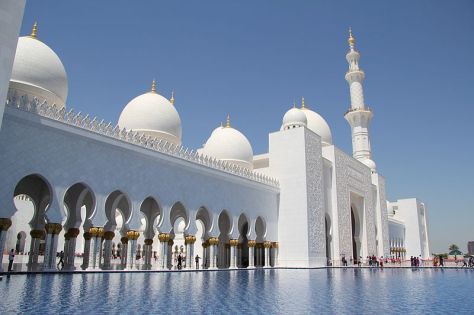
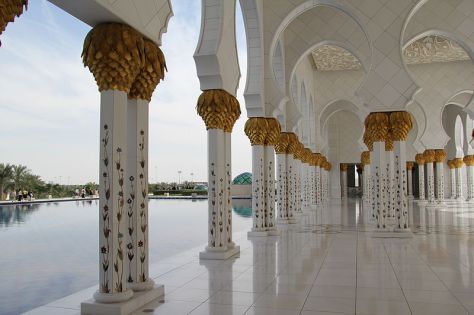
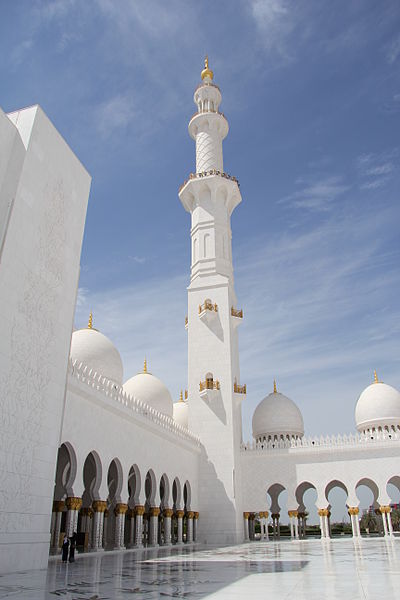
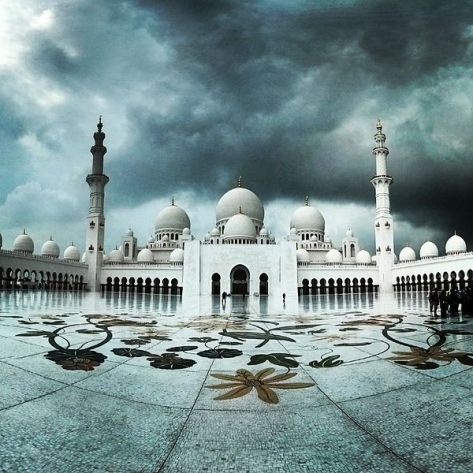
Source: Wikipedia
Decorative Stones of the Sheikh Zayed Grand Mosque, Abu Dhabi
After sharing my mangrove kayaking pictures for this week’s “Monday Geology Picture” post, I thought I would share some more pictures from my January 2012 trip to Abu Dhabi, United Arab Emirates. The day after kayaking, my friend Karima and I visited the stunningly beautiful and elaborate Sheikh Zayed Grand Mosque. This impressive mosque was built for an estimated $545 million USD, is the size of 5 football fields, and can accommodate 40,000 worshipers. The mosque was built over many years and opened in 2007. The mosque welcomes tourists as well as Islamic worshipers. For our visit to the mosque, Karima and I donned conservative, respectful clothing (long skirts, long sleeves, and headscarves) and joined a tour group. The mosque is breath-taking– it was hard to believe, sometimes, that it was real. At times, I felt as if we had stepped into a magical world. I greatly enjoyed my visit to the mosque and highly recommend the tour to anyone visiting Abu Dhabi.
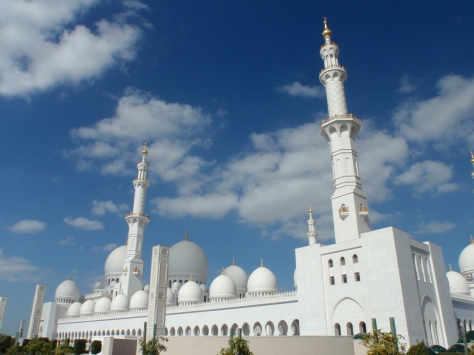
During the tour, I spent much of my time admiring the decorative building stones, which come in all colors, shapes, and lithologies and were likely sourced from all over the world. The primary building stone used in the mosque is a stunning white marble. I tried to identify the other decorative stones when I could. How many stones can you identify? Where do you think the stones might be from? Leave a comment below!
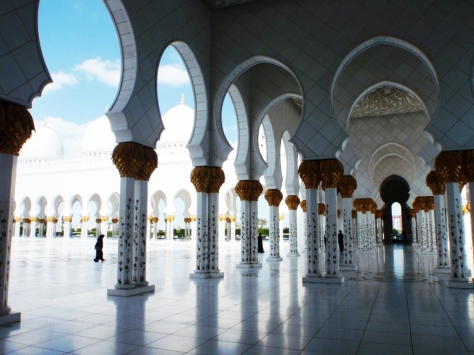
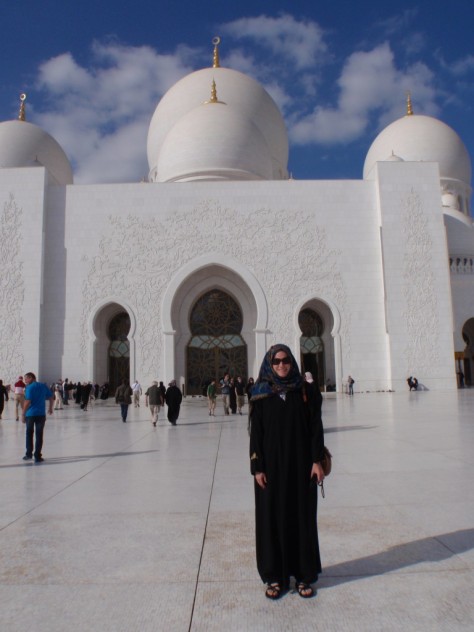

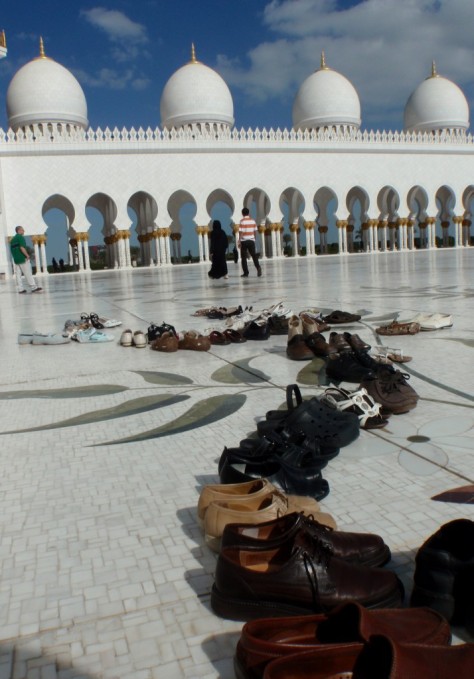

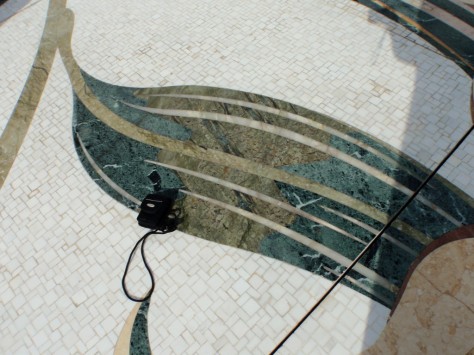
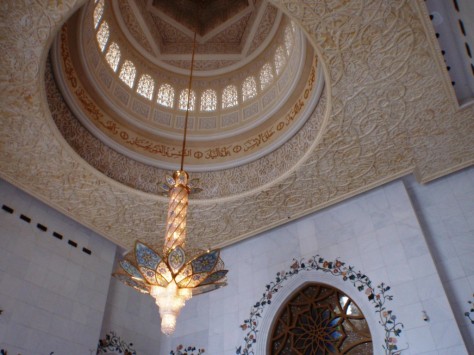
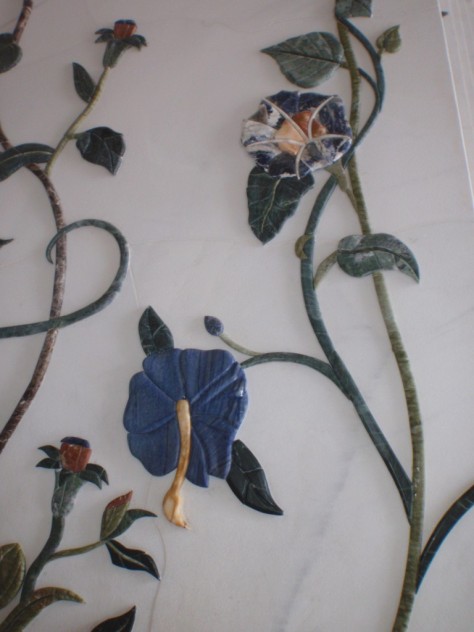

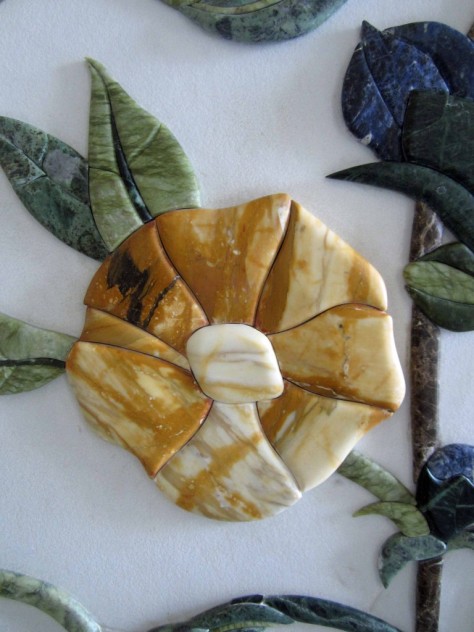

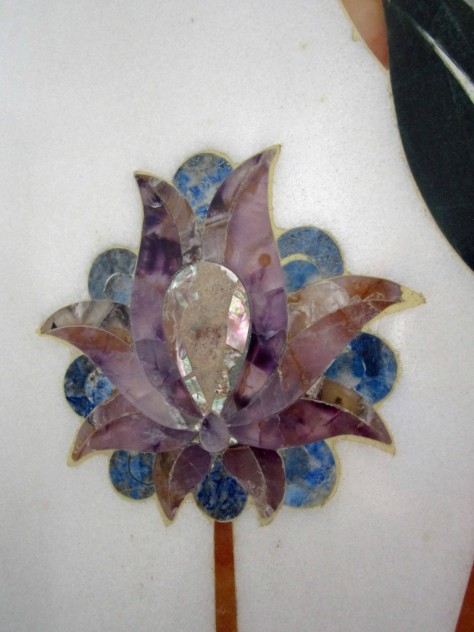
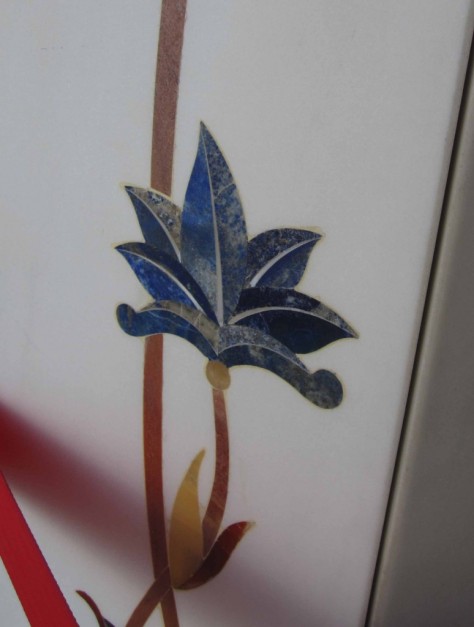
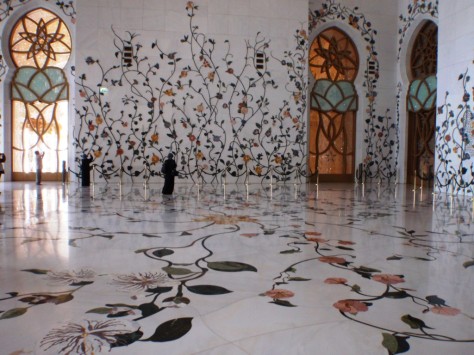

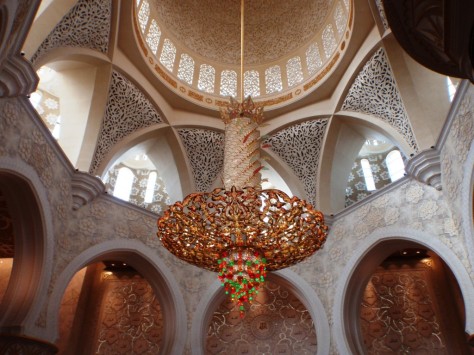
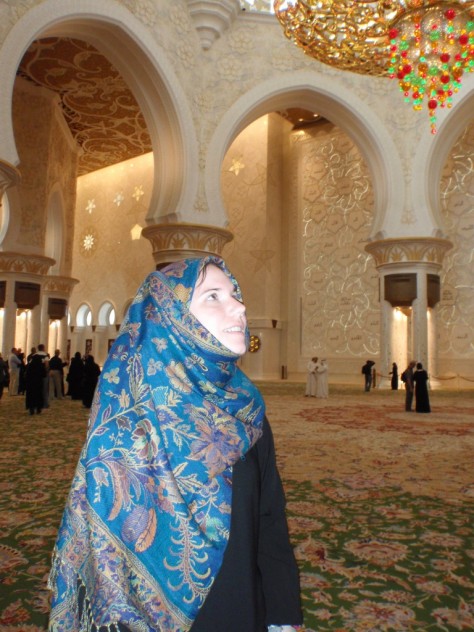
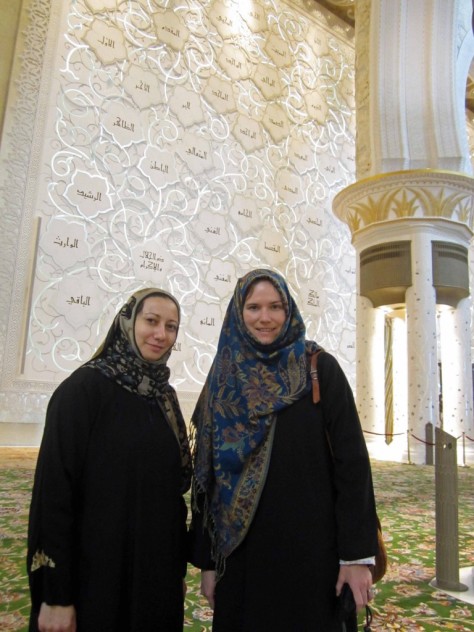
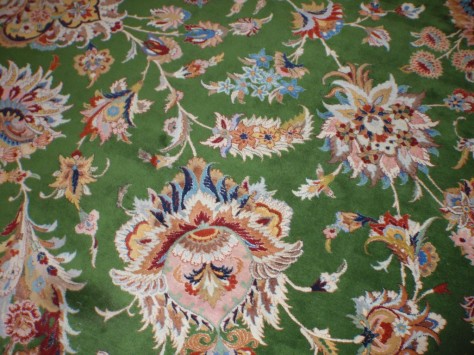
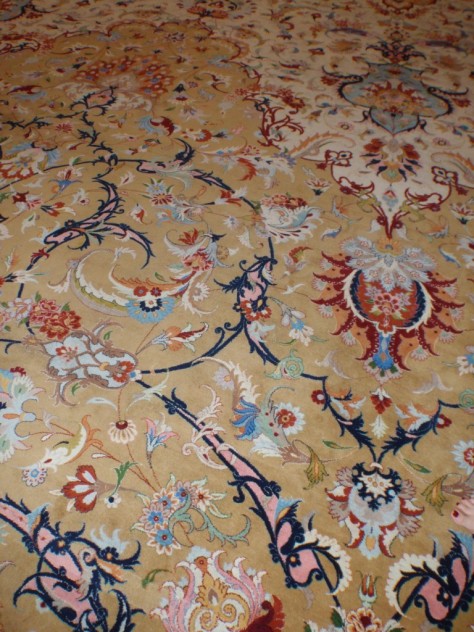
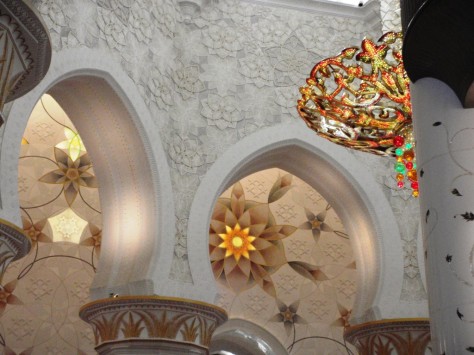
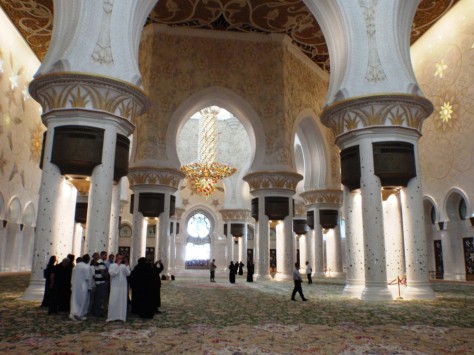
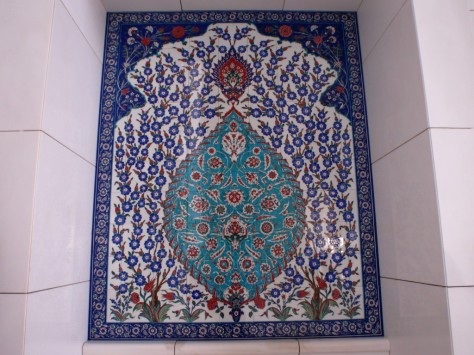


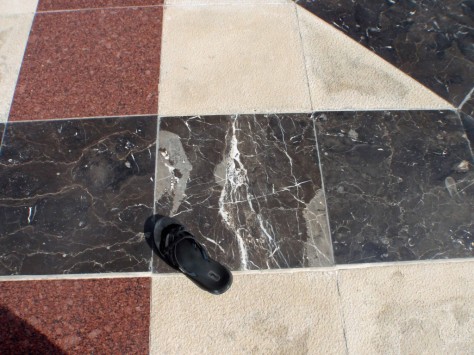
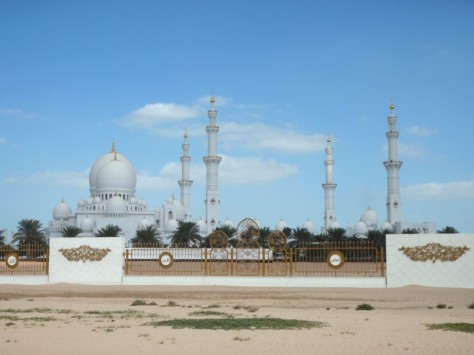
The list of many of the marbles and semi-precious stones that were used in the Sheikh Zayed Grand Mosque construction.
The different types of Major Marble supplied on site:
- SIVEC Supplier FHL Country of Origin Greece/Macedonia
- LASA Supplier Lasa Quarry Country of Origin Italy
- MAKARANA Supplier Country of Origin India
- AQUABIANCA Country of Origin Italy
- BIANCO P Supplier Carrara Country of Origin Italy
- MING GREEN Supplier UMGG Country of Origin China
- EAST WHITE Supplier UMGG Country of Origin China
The External Columns the stones used are:
- Dark Lapis lazuli
- Light Lapis lazuli
- Red Agate
- Dark Amethyst
- Light Amethyst
- Dark Green Adventure
- Light Green Adventure
- Moss Agate
- Pink Adventure
- Dark Red Adventure
- Light Red Adventure
- Abalone Shell
- White Mother of Pearl
- Fancy Jasper
- Sodalite
- Haqiq Red
- All Veins in Leaves: White Jambu
- Mehndi Pfizer
Detail of many Stones being used by Sheikh Zayed Mosque
1. Marble
Marble is a non-foliated metamorphic rock composed of recrystallized carbonate minerals, most commonly calcite or dolomite. Geologists use the term “marble” to refer to metamorphosed limestone; however, stonemasons use the term more broadly to encompass unmetamorphosed limestone. Marble is commonly used for sculpture and as a building material.
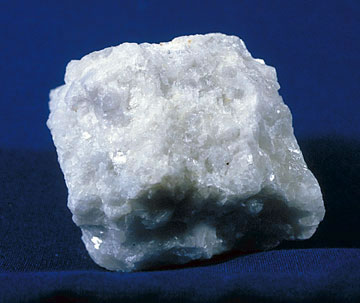
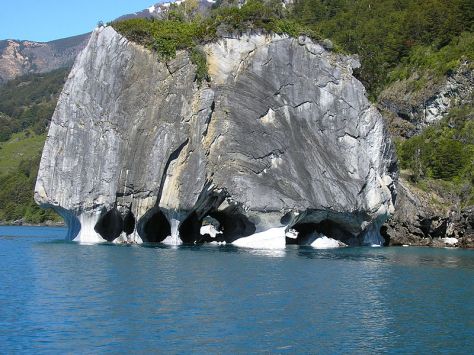
Etymology
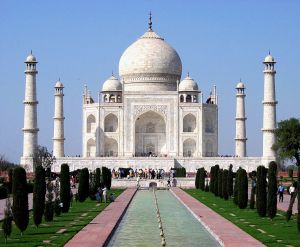
The word “marble” derives from the Greek μάρμαρον (mármaron),from μάρμαρος (mármaros), “crystalline rock, shining stone”, perhaps from the verb μαρμαίρω (marmaírō), “to flash, sparkle, gleam”; R. S. P. Beekes has suggested that a “Pre-Greek origin is probable.”
This stem is also the basis for the English word marmoreal, meaning “marble-like.” While the English term resembles the French marbre, most other European languages (e.g. Spanish mármol, Italian marmo, Portuguese mármore,Welsh marmor, German, Norwegian, Danish and Swedish marmor, Persian and Irish marmar, Dutch marmer,Slovenian marmor, Polish marmur, Turkish mermer, Czech mramor and Russian мрáмор) follow the original Greek.
Physical Origins
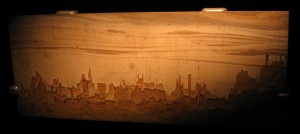
Marble is a rock resulting from metamorphism of sedimentary carbonate rocks, most commonly limestone or dolomite rock. Metamorphism causes variable recrystallization of the original carbonate mineral grains. The resulting marble rock is typically composed of an interlocking mosaic of carbonate crystals. Primary sedimentary textures and structures of the original carbonate rock (protolith) have typically been modified or destroyed.
Pure white marble is the result of metamorphism of a very pure (silicate-poor) limestone or dolomite protolith. The characteristic swirls and veins of many colored marble varieties are usually due to various mineral impurities such as clay, silt, sand, iron oxides, or chert which were originally present as grains or layers in the limestone. Green coloration is often due to serpentine resulting from originally high magnesium limestone or dolostone with silica impurities. These various impurities have been mobilized and recrystallized by the intense pressure and heat of the metamorphism.
Types
| Marble | Color | Location | Country |
|---|---|---|---|
| Carrara marble | white or blue-gray | Carrara | Italy |
| Al-Andalus marble | Red | Malaga | Spain |
| Black marble | Black, white veins | Tongshan County, Hubei | China |
| Costa Sol marble | Bronze | Malaga | Spain |
| San Cristobal Ivory Cream | Beige | Teba | Spain |
| Connemara marble | green | Connemara | Ireland |
| Creole marble | white and blue/black | Pickens County, Georgia | United States |
| Etowah marble | pink, salmon, rose | Pickens County, Georgia | United States |
| Murphy marble | white | Pickens and Gilmer Counties, Georgia | United States |
| Parian marble | pure-white, fine-grained | Island of Paros | Greece |
| Pentelic marble | pure-white, fine-grained semitranslucent | Penteliko Mountain, Athens | Greece |
| Purbeck marble | Gray/brown | Isle of Purbeck | United Kingdom |
| Ruskeala marble | white | near Ruskeala, Karelia | Russia |
| Rușchița marble | white, pinkish, reddish | Rușchița, Caraș-Severin County, Poiana Rusca Mountains | Romania |
| Sienna marble | yellow with violet, red, blue or white veins | near Siena, Tuscany | Italy |
| Bianco Sivec | white | near Prilep | Republic of Macedonia |
| Swedish green marble | green | near Kolmården, Södermanland | Sweden |
| Sylacauga marble | white | Talladega County, Alabama | United States |
| Vermont marble | white | Proctor, Vermont | United States |
| Yule marble | uniform pure white | near Marble, Colorado | United States |
| Wunsiedel marble | white | Wunsiedel, Bavaria | Germany |
Uses
Sculpture
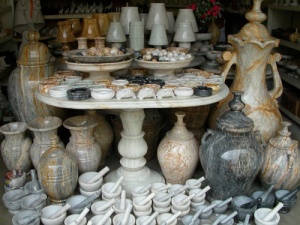
White marble has been prized for its use in sculptures since classical times. This preference has to do with its softness, which made it easier to carve, relative isotropy and homogeneity, and a relative resistance to shattering. Also, the low index of refraction of calcite allows light to penetrate several millimeters into the stone before being scattered out, resulting in the characteristic waxy look which gives “life” to marble sculptures of any kind, which is why many sculptors preferred and still prefer marble for sculpting.
Construction Marble
Construction marble is a stone which is composed of calcite, dolomite or serpentine which is capable of taking a polish. More generally in construction, specifically the dimension stone trade, the term “marble” is used for any crystalline calcitic rock (and some non-calcitic rocks) useful as building stone. For example, Tennessee marble is really a dense granular fossiliferous gray to pink to maroon Ordovician limestone that geologists call the Holston Formation.
In 2013, the Ashgabat city was included in the Guinness Book of Records as the world’s highest concentration of white marble buildings.
Production
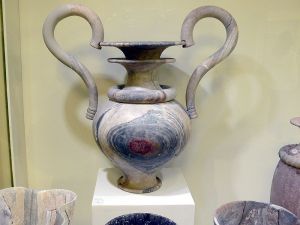
According to the United States Geological Survey, U.S. domestic marble production in 2006 was 46,400 tons valued at $18.1 million, compared to 72,300 tons valued at $18.9 million in 2005. Crushed marble production (for aggregate and industrial uses) in 2006 was 11.8 million tons valued at $116 million, of which 6.5 million tons was finely ground calcium carbonate and the rest was construction aggregate. For comparison, 2005 crushed marble production was 7.76 million tons valued at $58.7 million, of which 4.8 million tons was finely ground calcium carbonate and the rest was construction aggregate. U.S. dimension marble demand is about 1.3 million tons. The DSAN World Demand for (finished) Marble Index has shown a growth of 12% annually for the 2000–2006 period, compared to 10.5% annually for the 2000–2005 period. The largest dimension marble application is tile.
Marble production is dominated by 4 countries that account for almost half of world production of marble and decorative stone. Italy is the world leader in marble production, with 20% share in global marble production followed by China with 16% of world production. India is third ranking with 10% of world production, followed by Spain in fourth ranking position with 6% of world production. The other marble producing countries of the world represent the remaining other half of world marble production.
Microbial Degradation
The haloalkaliphilic methylotrophic bacterium Methylophaga murata was isolated from deteriorating marble in the Kremlin.Bacterial and fungal degradation was detected in four samples of marble from Milan cathedral; black Cladosporium attacked dried acrylic resin using melanin.
Cultural Associations
As the favorite medium for Greek and Roman sculptors and architects (see classical sculpture), marble has become a cultural symbol of tradition and refined taste. Its extremely varied and colorful patterns make it a favorite decorative material, and it is often imitated in background patterns for computer displays, etc.

Places named after the stone include Marblehead, Ohio; Marblehead, Massachusetts; Marble Arch, London; the Sea of Marmara; India’s Marble Rocks; and the towns of Marble, Minnesota; Marble, Colorado; Marble Falls, Texas, andMarble Hill, Manhattan, New York. The Elgin Marbles are marble sculptures from the Parthenon that are on display in the British Museum. They were brought to Britain by the Earl of Elgin.
Artificial Marble
Marble dust is combined with cement or synthetic resins to make reconstituted or cultured marble. The appearance of marble can be simulated with faux marbling, a painting technique that imitates the stone’s color patterns.
Source: Wikipedia
2. Lapis Lazuli
Lapis lazuli /ˈlæpɪs ləˈzuːliː/ or /ˈlæʒuːlaɪ/ (sometimes abbreviated to lapis) is a deep blue semi-precious stone that has been prized since antiquity for its intense color.

Lapis lazuli was being mined in the Sar-i Sang mines and in other mines in the Badakhshan province in northeast Afghanistan as early as the 7th millennium BC,Lapis beads have been found at neolithic burials inMehrgarh, the Caucasus, and even as far from Afghanistan as Mauritania. It was used for the eyebrows on the funeral mask of King Tutankhamun (1341–1323 BC).
At the end of the Middle Ages, lapis lazuli began to be exported to Europe, where it was ground into powder and made into ultramarine, the finest and most expensive of all blue pigments. It was used by the most important artists of the Renaissance and Baroque, including Masaccio, Perugino, Titian and Vermeer, and was often reserved for the clothing of the central figure of the painting, especially the Virgin Mary.
Today mines in northeast Afghanistan are still the major source of lapis lazuli. Important amounts are also produced from mines west of Lake Baikal in Russia, and in the Andes mountains in Chile. Smaller quantities are mined in Italy, Mongolia, the United States and Canada
Etymology
Lapis is the Latin word for “stone” and lazuli is the genitive form of the Medieval Latin lazulum, which is taken from the Arabic لازورد lāzaward, itself from the Persian لاژورد lāžaward, which is the name of the stone in Persian and also of a place where lapis lazuli was mined.
The name of the stone came to be associated with its color. The English word azure, French azur, the Italian azzurro, the Polish lazur, Romanian azur andazuriu, and the Portuguese and Spanish azul, Hungarian azúr all come from the name and color of lapis lazuli.
Science and Uses
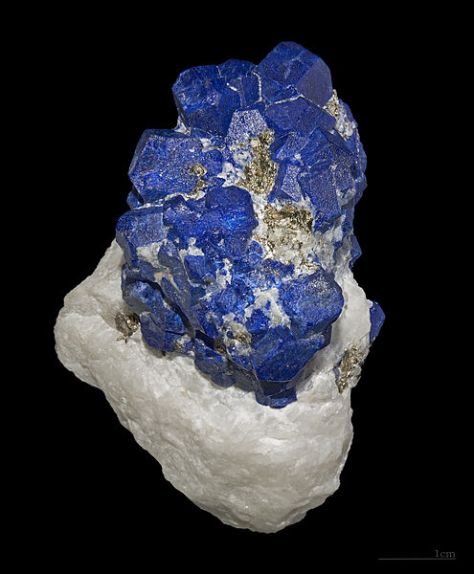

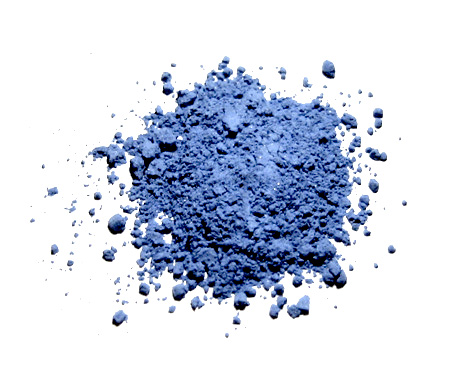
Composition
Lapis lazuli is a rock whose most important mineral component is lazurite (25% to 40%), a feldspathoid silicate mineral with the formula (Na,Ca)8(AlSiO4)6(S,SO4,Cl)1-2. Most lapis lazuli also contains calcite (white), sodalite (blue), and pyrite (metallic yellow). Other possible constituents:augite; diopside; enstatite; mica; hauynite; hornblende, and nosean. Some lapis lazuli contains trace amounts of the sulfur-rich löllingite variety geyerite.
Lapis lazuli usually occurs in crystalline marble as a result of contact metamorphism.
Color
The intense blue color is due to the presence of the S3– radical anion in the crystal. An electronic excitation of one electron from the highest doubly filledmolecular orbital (No. 24) into the lowest singly occupied orbital (No. 25) results in a very intense absorption line at λmax ~617 nm.
Sources
Lapis lazuli is found in limestone in the Kokcha River valley of Badakhshan province in northeastern Afghanistan, where the Sar-e-Sang mine deposits have been worked for more than 6,000 years. Afghanistan was the source of lapis for the ancient Egyptian and Mesopotamian civilizations, as well as the later Greeks and Romans. Ancient Egyptians obtained this material through trade from Afghanistan. During the height of the Indus valley civilization about 2000 BC, the Harappan colony now known as Shortugai was established near the lapis mines.
In addition to the Afghan deposits, lapis is also extracted in the Andes (near Ovalle, Chile); and to the west of Lake Baikal in Siberia, Russia, at the Tultui Lazurite deposit. It is mined in smaller amounts Angola; Argentina; Burma; Pakistan; Canada; Italy, India; and in the USA in California and Colorado.
Alternatives
Lapis lazuli is commercially synthesized or simulated by the Gilson process, which is used to make artificial ultramarine and hydrous zinc phosphates.[14] It may also be substituted by spinel or sodalite, or by dyed jasper or howlite.
Uses
Lapis takes an excellent polish and can be made into jewelry, carvings, boxes, mosaics, ornaments, and vases. It was also ground and processed to make thepigment ultramarine, widely used during the Renaissance in frescoes and oil painting. Its usage as a pigment in oil paint largely ended in the early 19th century when a chemically identical synthetic variety became available.
History and Art
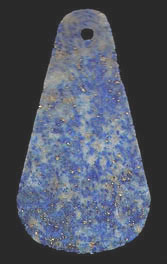

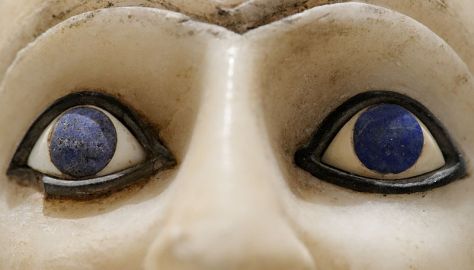
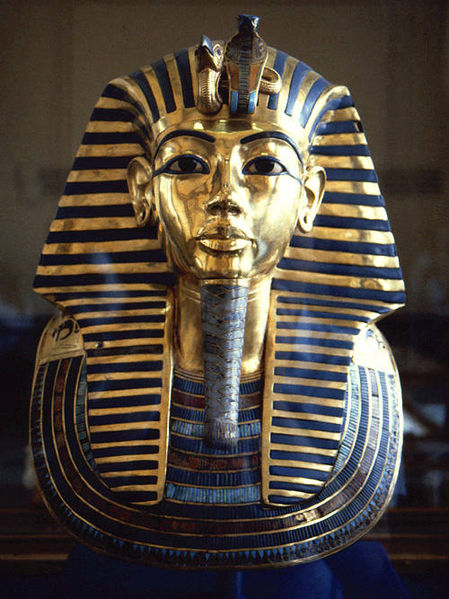

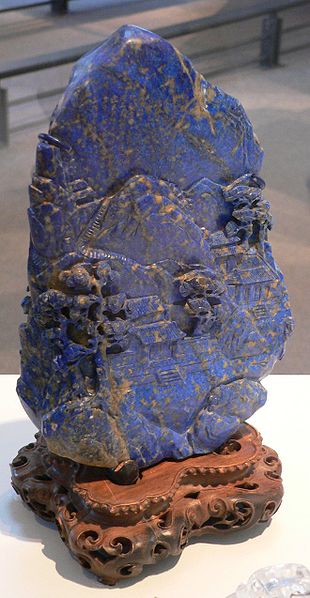


In the Ancient World
Lapis lazuli has been mined in Afghanistan and exported to the Mediterranean world and South Asia since the Neolithic age. Lapis lazuli beads have been found at Mehrgarh, a neolithic site near Quetta in Pakistan, on the ancient trade route between Afghanistan and the Indus Valley, dating to the 7th millennium. Quantities of these beads have also been found at 4th millennium BC settlements in Northern Mesopotamia, and at the Bronze Age site of Shahr-e Sukhteh in southeast Iran (3rd millennium BC). A dagger handle with a lapis handle, a bowl inlaid with lapis, and amulets, beads, and inlays representing eyebrows and beards, were found in the Royal Tombs of the Sumerian city-state of Ur from the 3rd Millennium BC.
Lapis was also used in ancient Mesopotamia by the Akkadians, Assyrians, and Babylonians for seals and jewelry. In the Mesopotamian poem, the Epic of Gilgamesh (17th-18th Century BC); one of the oldest known works of literature, lapis lazuli is mentioned several times. The Statue of Ebih-Il, a 3rd millennium BC statue found in the ancient city-state of Mari in modern-day Syria, now in the Louvre, uses lapis lazuli inlays for the irises of the eyes.
Lapis lazuli also made its way across the Mediterranean to ancient Egypt, where it was a favorite stone for amulets and ornaments such as scarabs; Lapis jewelry has been found at excavations of the Predynastic Egyptian site Naqada (3300–3100 BC). At Karnak, the relief carvings of Thutmose III (1479-1429 BC) show fragments and barrel-shaped pieces lapis lazuli being delivered to him as tribute. Powdered lapis was used as eyeshadow by Cleopatra.
In late classical times and as late as the Middle Ages, lapis lazuli was often called sapphire (sapphirus in Latin, sappir in Hebrew), though it had little to do with the stone today known as the blue corundum variety sapphire. In his book on stones, the Greek scientist Theophrastus described “the sapphirus, which is speckled with gold,” a description which matches lapis lazuli.
There are many references to sapphires in the Old Testament, but most scholars agree that, since sapphires were not known before the Roman Empire, they most likely are references to lapis lazuli. For instance, Exodus 24:10: “As they saw the God of Israel, and there was under his feet as it were a paved work of a sapphire stone..” (KJV). The term used in the Latin Vulgate Bible in this citation is “lapidus sapphiri,” the term for lapis lazuli. In modern translations of the Bible, such as the New Living Translation Second Edition, references a surface like brilliant blue lapis lazuli as clear as the sky as being under God’s feet.
Source: Wikipedia
3. Agate
Agate /ˈæɡət/ is a cryptocrystalline variety of silica, chiefly chalcedony, characterised by its fineness of grain and brightness of color. Although agates may be found in various kinds of rock, they are classically associated with volcanic rocks and can be common in certain metamorphic rocks.
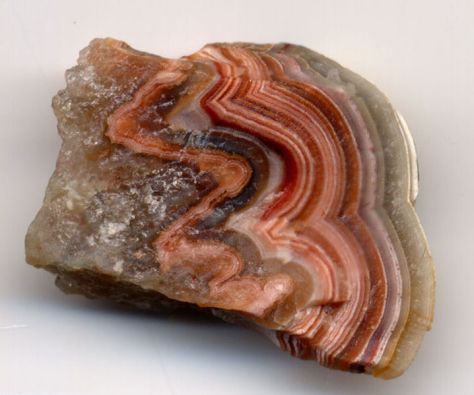
Etymology and History
The stone was given its name by Theophrastus, a Greek philosopher and naturalist, who discovered the stone along the shore line of the river Achates (Greek: Ἀχάτης) sometime between the 4th and 3rd centuries BC.Colorful agates and other chalcedonies were obtained over 3,000 years ago from the Achates River, now calledDirillo, in Sicily.
Ancient Use
Agate is one of the most common materials used in the art of hardstone carving, and has been recovered at a number of ancient sites, indicating its widespread use in the ancient world; for example, archaeological recovery at the Knossos site on Crete illustrates its role in Bronze Age Minoan culture.
Formation and Characteristics
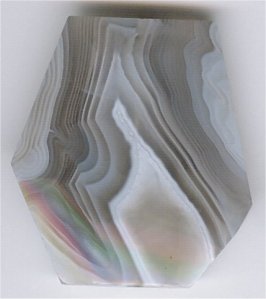
Most agates occur as nodules in volcanic rocks or ancient lavas, in former cavities produced by volatiles in the original molten mass, which were then filled, wholly or partially, by siliceous matter deposited in regular layers upon the walls. Agate has also been known to fill veins or cracks in volcanic or altered rock underlain by granitic intrusive masses. Such agates, when cut transversely, exhibit a succession of parallel lines, often of extreme tenuity, giving a banded appearance to the section. Such stones are known as banded agate, riband agate andstriped agate.
In the formation of an ordinary agate, it is probable that waters containing silica in solution—derived, perhaps, from the decomposition of some of the silicates in the lava itself—percolated through the rock and deposited a siliceous coating on the interior of the vesicles. Variations in the character of the solution or in the conditions of deposition may cause a corresponding variation in the successive layers, so that bands of chalcedony often alternate with layers of crystalline quartz. Several vapour-vesicles may unite while the rock is still viscous, and thus form a large cavity which may become the home of an agate of exceptional size; thus a Brazilian geode lined with amethyst and weighing 35 tons was exhibited at the Düsseldorf Exhibition of 1902. Perhaps the most comprehensive review of agate chemistry is a recent text by Moxon cited below.
The first deposit on the wall of a cavity, forming the “skin” of the agate, is generally a dark greenish mineral substance, like celadonite, delessite or “green earth”, which are rich in iron probably derived from the decomposition of the augite in the enclosing volcanic rock. This green silicate may give rise by alteration to a brown iron oxide (limonite), producing a rusty appearance on the outside of the agate-nodule. The outer surface of an agate, freed from its matrix, is often pitted and rough, apparently in consequence of the removal of the original coating. The first layer spread over the wall of the cavity has been called the “priming”, and upon this base, zeolitic minerals may be deposited.
Many agates are hollow, since deposition has not proceeded far enough to fill the cavity, and in such cases the last deposit commonly consists of drusy quartz, sometimes amethystine, having the apices of the crystals directed towards the free space so as to form a crystal-lined cavity or geode.
When the matrix in which the agates are embedded disintegrates, they are set free. The agates are extremely resistant to weathering and remain as nodules in the soil, or are deposited as gravel in streams and along shorelines.
Types of Agate
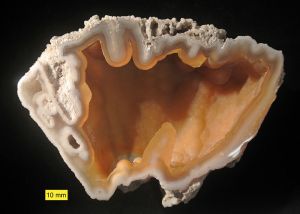
A Mexican agate, showing only a single eye, has received the name of cyclops agate. Included matter of a green, golden, red, black or other color or combinations embedded in the chalcedony and disposed in filaments and other forms suggestive of vegetable growth, gives rise to dendritic or moss agate. Dendritic agates have fern like patterns in them formed due to the presence of manganese and iron oxides. Other types of included matter deposited during agate-building include sagenitic growths (radial mineral crystals) and chunks of entrapped detritus (such as sand, ash, or mud). Occasionally agate fills a void left by decomposed vegetative material such as a tree limb or root and is called limb cast agate due to its appearance. Enhydro agate contains tiny inclusions of water, sometimes with air bubbles.
Turritella agate is formed from silicified fossil Elimia tenera (erroneously considered Turritella) shells. E. tenera are spiral freshwater gastropodshaving elongated, spiral shells composed of many whorls. Similarly, coral, petrified wood and other organic remains or porous rocks can also become agatized. Agatized coral is often referred to as Petoskey stone or agate.

Greek agate is a name given to pale white to tan colored agate found in Sicily back to 400 B.C. The Greeks used it for making jewelry and beads. Even though the stone had been around centuries and was known to both the Sumerians and the Egyptians, both who used the gem for decoration and for playing important parts in their religious ceremonies, any agate of this color from Sicily, once an ancient Greek colony, is called Greek agate.
Another type of agate is Brazilian agate, which is found as sizable geodes of layered nodules. These occur in brownish tones interlayered with white and gray. Quartz forms within these nodules, creating a striking specimen when cut opposite the layered growth axis. It is often dyed in various colors for ornamental purposes.
Certain stones, when examined in thin sections by transmitted light, show a diffraction spectrum due to the extreme delicacy of the successive bands, whence they are termed rainbow agates. Often agate coexists with layers or masses of opal, jasper or crystalline quartz due to ambient variations during the formation process.
Other forms of agate include Lake Superior agate; carnelian agate (has reddish hues); Botswana agate; blue lace agate; plume agate; condor agate, tube agate (with visible flow channels or pinhole-sized “tubes”); fortification agate (with contrasting concentric banding reminiscent of defensive ditches and walls around ancient forts); fire agate (showing internal flash or “fire”, the result of a layer of clear agate over a layer of hydrothermally deposited hematite); and Mexican crazy-lace agate, which often exhibits a brightly colored, complexly banded pattern (also called Rodeo Agate and Rosetta Stone depending on who owned the mine at the time).
Uses in Industry and Art
 Industry uses agates chiefly to make ornaments such as pins, brooches or other types of jewelry, paper knives, inkstands, marbles and seals. Agate is also still used today for decorative displays, cabochons, beads, carvings and Intarsia art as well as face-polished and tumble-polished specimens of varying size and origin. Because of its hardness and ability to resist acids, agate is used to make mortars and pestles to crush and mix chemicals. Because of the high polish possible with agate it has been used for centuries for leather burnishing tools. Idar-Oberstein was one of the centers which made use of agate on an industrial scale. Where in the beginning locally found agates were used to make all types of objects for the European market, this became a globalized business around the turn of the 20th century: Idar-Oberstein imported large quantities of agate from Brazil, as ship’s ballast. Making use of a variety of proprietary chemical processes, they produced colored beads that were sold around the globe. Agates have long been used in arts and crafts. The sanctuary of a Presbyterian church in Yachats, Oregon, has six windows with panes made of agates collected from the local beaches.
Industry uses agates chiefly to make ornaments such as pins, brooches or other types of jewelry, paper knives, inkstands, marbles and seals. Agate is also still used today for decorative displays, cabochons, beads, carvings and Intarsia art as well as face-polished and tumble-polished specimens of varying size and origin. Because of its hardness and ability to resist acids, agate is used to make mortars and pestles to crush and mix chemicals. Because of the high polish possible with agate it has been used for centuries for leather burnishing tools. Idar-Oberstein was one of the centers which made use of agate on an industrial scale. Where in the beginning locally found agates were used to make all types of objects for the European market, this became a globalized business around the turn of the 20th century: Idar-Oberstein imported large quantities of agate from Brazil, as ship’s ballast. Making use of a variety of proprietary chemical processes, they produced colored beads that were sold around the globe. Agates have long been used in arts and crafts. The sanctuary of a Presbyterian church in Yachats, Oregon, has six windows with panes made of agates collected from the local beaches.
Health Impact

Respiratory diseases such as Silicosis and higher incidence of Tuberculosis among workers involved in the agate industry has been reported from India and China.
Source: Wikipedia
4. Amethyst
Amethyst is a violet variety of quartz often used in jewelry. The name comes from the Ancient Greek ἀ a- (“not”) and μέθυστος methustos (“intoxicated”), a reference to the belief that the stone protected its owner fromdrunkenness. The ancient Greeks and Romans wore amethyst and made drinking vessels of it in the belief that it would prevent intoxication. It is one of several forms of quartz. Amethyst is a semiprecious stone and is the traditional birthstone for February.
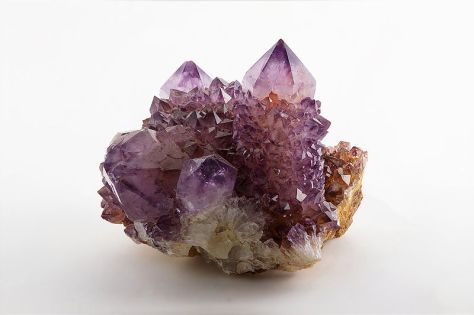
Structure
Amethyst is a purple variety of quartz (SiO2) and owes its violet color to irradiation, iron impurities (in some cases in conjunction with transition element impurities), and the presence of trace elements, which result in complex crystal lattice substitutions. The hardness of the mineral is the same as quartz, thus it is suitable for use in jewelry.
Hue and Tone
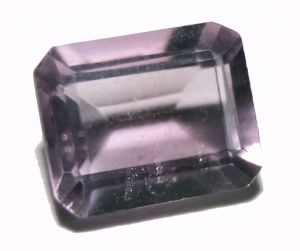
Amethyst occurs in primary hues from a light pinkish violet to a deep purple. Amethyst may exhibit one or both secondary hues, red and blue. The best varieties of Amethysts can be found in Siberia, Sri Lanka, Brazil and the far East. The ideal grade is called “Deep Siberian” and has a primary purple hue of around 75–80%, with 15–20% blue and (depending on the light source) red secondary hues. Green quartz is sometimes incorrectly called green amethyst, which is a misnomer and not an appropriate name for the material, the proper terminology being Prasiolite. Other names for green quartz are vermarine or lime citrine.
Of very variable intensity, the color of amethyst is often laid out in stripes parallel to the final faces of the crystal. One aspect in the art of lapidaryinvolves correctly cutting the stone to place the color in a way that makes the tone of the finished gem homogeneous. Often, the fact that sometimes only a thin surface layer of violet color is present in the stone or that the color is not homogeneous makes for a difficult cutting.
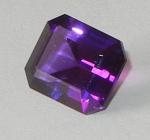
The color of amethyst has been demonstrated to result from substitution by irradiation of trivalent iron (Fe3+) for silicon in the structure, in the presence of trace elements of large ionic radius, and, to a certain extent, the amethyst color can naturally result from displacement of transition elements even if the iron concentration is low. Natural amethyst is dichroic in reddish violet and bluish violet, but when heated, turns yellow-orange, yellow-brown, or dark brownish and may resemble citrine, but loses its dichroism, unlike genuine citrine. When partially heated, amethyst can result in ametrine.
Amethyst can fade in tone if overexposed to light sources and can be artificially darkened with adequate irradiation.
History

Amethyst was used as a gemstone by the ancient Egyptians and was largely employed in antiquity for intaglio engraved gems.
The Greeks believed amethyst gems could prevent intoxication, while medieval European soldiers wore amethyst amulets as protection in battle in the belief that amethysts heal people and keep them cool-headed. Beads of amethyst were found in Anglo-Saxon graves in England.
A large geode, or “amethyst-grotto”, from near Santa Cruz in southern Brazil was presented at the 1902 exhibition inDüsseldorf, Germany.
In the 19th century, the color of amethyst was attributed to the presence of manganese. However, since it is capable of being greatly altered and even discharged by heat, the color was believed by some authorities to be from an organic source. Ferric thiocyanate has been suggested, and sulfur was said to have been detected in the mineral.
Synthetic Amethyst
Synthetic amethyst is produced by gamma-ray, x-ray or electron beam irradiation of clear quartz which has been first doped with ferric impurities. On exposure to heat, the irradiation effects can be partially cancelled and amethyst generally becomes yellow or even green, and much of the citrine, cairngorm, or yellow quartz of jewelry is said to be merely “burnt amethyst”.
Synthetic amethyst is made to imitate the best quality amethyst. Its chemical and physical properties are so similar to that of natural amethyst that it can not be differentiated with absolute certainty without advanced gemnological testing (which is often cost-prohibitive). There is one test based on “Brazil law twinning” (a form of quartz twinning where right and left hand quartz structures are combined in a single crystal) which can be used to identify synthetic amethyst rather easily. It is possible to synthesize twinned amethyst, but this type is not available in large quantities in the market.
Mythology
The Greek word “amethystos” may be translated as “not drunken”, from Greek a-, “not” + methustos, “intoxicated”. Amethyst was considered to be a strong antidote against drunkenness, which is why wine goblets were often carved from it. In his poem “L’Amethyste, ou les Amours de Bacchus et d’Amethyste” (Amethyst or the loves of Bacchus and Amethyste), the French poet Remy Belleau (1528–1577) invented a myth in which Bacchus, the god of intoxication, of wine, and grapes was pursuing a maiden named Amethyste, who refused his affections. Amethyste prayed to the gods to remain chaste, a prayer which the chaste goddess Diana answered, transforming her into a white stone. Humbled by Amethyste’s desire to remain chaste, Bacchus poured wine over the stone as an offering, dyeing the crystals purple.
Variations of the story include that Dionysus had been insulted by a mortal and swore to slay the next mortal who crossed his path, creating fierce tigers to carry out his wrath. The mortal turned out to be a beautiful young woman, Amethystos, who was on her way to pay tribute to Artemis. Her life was spared by Artemis, who transformed the maiden into a statue of pure crystalline quartz to protect her from the brutal claws. Dionysus wept tears of wine in remorse for his action at the sight of the beautiful statue. The god’s tears then stained the quartz purple.
This myth and its variations are not found in classical sources. Although the titan Rhea does present Dionysus with an amethyst stone to preserve the wine-drinker’s sanity in historical text.
Geographic Distribution
Amethyst is produced in abundance from the state of Minas Gerais in Brazil where it occurs in large geodes within volcanic rocks. Many of the hollow agates of southwestern Brazil and Uruguay contain a crop of amethyst crystals in the interior. Artigas, Uruguay and neighboring Brazilian state Rio Grande do Sul are large world producers exceeding in quantity Minas Gerais, as well as Mato Grosso, Espirito Santo, Bahia, and Ceará states, all amethyst producers of importance in Brazil.
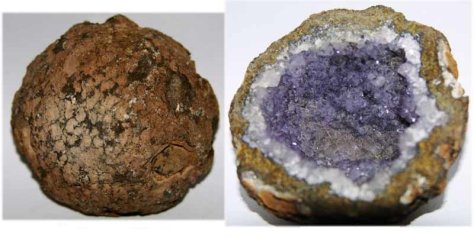
It is also found and mined in South Korea. The largest opencast amethyst vein in the world is in Maissau, Lower Austria. Much fine amethyst comes fromRussia, especially from near Mursinka in the Ekaterinburg district, where it occurs in drusy cavities in granitic rocks. Many localities in south India yield amethyst. One of the largest global amethyst producers is Zambia in southern Africa with an annual production of about 1000 tonnes.
Amethyst occurs at many localities in the United States. Among these may be mentioned: the Mazatzal Mountain region in Gila and Maricopa Counties,Arizona; Red Feather Lakes, near Ft Collins, Colorado; Amethyst Mountain, Texas; Yellowstone National Park; Delaware County, Pennsylvania; Haywood County, North Carolina; Deer Hill and Stow, Maine and in the Lake Superior region of Minnesota, Wisconsin and Michigan. Amethyst is relatively common in the Canadian provinces of Ontario and Nova Scotia. The largest amethyst mine in North America is located in Thunder Bay, Ontario.
Value
Up until the 18th century, amethyst was included in the cardinal, or most valuable, gemstones (along with diamond, sapphire, ruby, and emerald). However, since the discovery of extensive deposits in locations such as Brazil, it has lost most of its value.
Collectors look for depth of color, possibly with red flashes if cut conventionally.As amethyst is readily available in large structures the value of the gem is not primarily defined by carat weight; this is different to most gemstones where the carat weight exponentially increases the value of the stone. The biggest factor in the value of amethyst is the colour displayed.
The highest grade amethyst (called “Deep Russian”) is exceptionally rare and therefore, when one is found, its value is dependent on the demand of collectors. It is, however, still orders of magnitude lower than the highest grade sapphires or rubies (padparadscha sapphire or “pigeon’s blood” ruby).
5. Jasper
Jasper, a form of chalcedony, is an opaque, impure variety of silica, usually red, yellow, brown or green in color; and rarely blue. The common red color is due to iron(III) inclusions in what is basically a chert. The mineral breaks with a smooth surface, and is used for ornamentation or as a gemstone. It can be highly polished and is used for vases,seals, and snuff boxes. The specific gravity of jasper is typically 2.5 to 2.9.[3] Along with Heliotrope (bloodstone), jasper is one of the traditional birthstones for March. Jaspilite is a banded iron formation rock that often has distinctive bands of jasper.
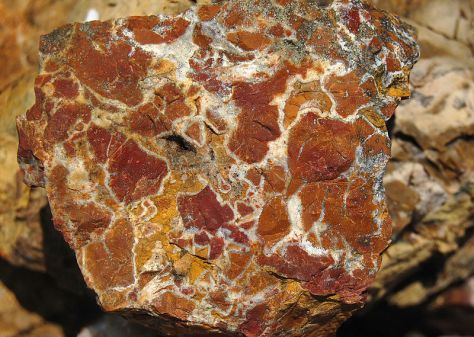
Etymology and History
![Moveable ring from 664 to 322 BC (Late Period). Green jasper and gold.[4] The Walters Art Museum](https://sudardjattanusukma.files.wordpress.com/2014/07/508px-egyptian_-_finger_ring_with_a_representation_of_ptah_-_walters_42387_-_side_a.jpg?w=254&h=300)
The name means “spotted or speckled stone”, and is derived via Old French jaspre (variant of Anglo-Norman jaspe) and Latiniaspidem (nom. iaspis)) from Greek ἴασπις iaspis, (feminine noun) from a Semitic language (cf. Hebrew יושפה yushphah,Akkadian yashupu).
Green jasper was used to make bow drills in Mehrgarh between 4th and 5th millennium BC. Jasper is known to have been a favorite gem in the ancient world; its name can be traced back in Arabic, Persian, Hebrew, Assyrian, Greek and Latin. OnMinoan Crete, jasper was carved to produce seals circa 1800 BC, as evidenced by archaeological recoveries at the palace ofKnossos.
Although the term jasper is now restricted to opaque quartz, the ancient iaspis was a stone of considerable translucency. The jasper of antiquity was in many cases distinctly green, for it is often compared to the emerald and other green objects. Jasper is referred to in the Niebelungenlied as being clear and green. Probably the jasper of the ancients included stones which would now be classed as chalcedony, and the emerald-like jasper may have been akin to the modern chrysoprase. The Hebrew word yushphah may have designated a green jasper. Flinders Petrie suggested that the odem, the first stone on the High Priest’s breastplate, was a red jasper, whilst tarshish, the tenth stone, may have been a yellow jasper.
Types

Jasper is an opaque rock of virtually any color stemming from the mineral content of the original sediments or ash. Patterns arise during the consolidation process forming flow and depositional patterns in the original silica richsediment or volcanic ash. Hydrothermal circulation is generally thought to be required in the formation of jasper.
Jasper can be modified by the diffusion of minerals along discontinuities providing the appearance of vegetative growth, i.e., dendritic. The original materials are often fractured and/or distorted, after deposition, into myriad beautiful patterns which are to be later filled with other colorful minerals. Weathering, with time, will create intensely colored superficial rinds.
The classification and naming of jasper presents a challenge. Terms attributed to various well-defined materials includes the geographic locality where it is found, sometimes quite restricted such as “Bruneau” (a canyon) and “Lahontan” (a lake), rivers and even individual mountains, many are fanciful such as “Forest Fire” or “Rainbow”, while others are descriptive such as “Autumn”, “Porcelain” or “Dalmatian”. A few are designated by the country of origin such as a Brown Egyptian or Red African leaving tremendous latitude as to what is called what.
Picture jaspers exhibit combinations of patterns (such as banding from flow or depositional patterns (from water or wind), dendritic or color variations) resulting in what appear to be scenes or images, on a cut section. Diffusion from a center produces a distinctive orbicular appearance, i.e., Leopard Skin Jasper, or linear banding from a fracture as seen in Leisegang Jasper. Healed, fragmented rock produces brecciated (broken) jasper. Examples of this can be seen at Llanddwyn Island in Wales.
The term basanite has occasionally been used to refer to a variety of jasper, for example a black flinty or cherty jasper found in several New England states of the USA. Such varieties of jasper are also informally known as Lydian stone or lydite and have been used as touchstones in testing the purity of precious metal alloys.
Gallery
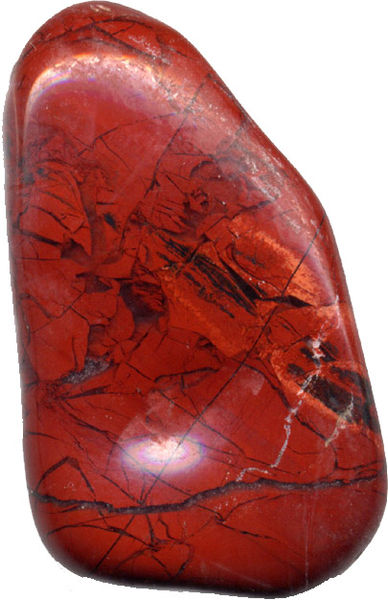



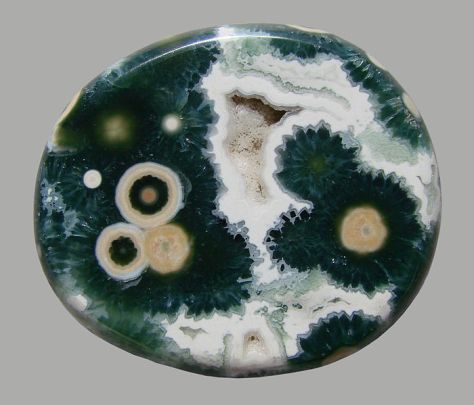
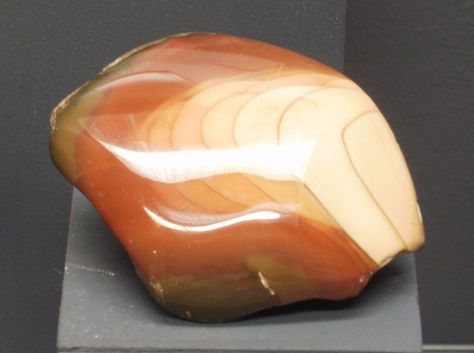
Source: Wikipedia
6. Carnelian
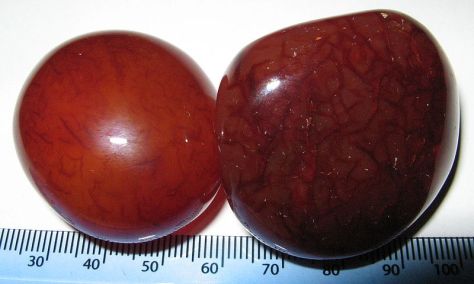
Carnelian (also spelled cornelian) is a brownish-red mineral which is commonly used as a semi-precious gemstone. Similar to carnelian is sard, which is generally harder and darker (the difference is not rigidly defined, and the two names are often used interchangeably). Both carnelian and sard are varieties of the silica mineral chalcedony colored by impurities of iron oxide. The color can vary greatly, ranging from pale orange to an intense almost-black coloration. It is most commonly found in Brazil, India, Siberia, and Germany.
History
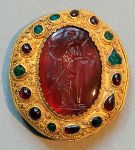
The bow drill was used to drill holes into carnelian in Mehrgarh between 4th-5th millennium BC. Carnelian was recovered from Bronze AgeMinoan layers at Knossos on Crete in a form that demonstrated its use in decorative arts; this use dates to approximately 1800 BC. Carnelian was used widely during Roman times to make engraved gems for signet or seal rings for imprinting a seal with wax on correspondence or other important documents. Hot wax does not stick to carnelian. Sard was used for Assyrian cylinder seals, Egyptian andPhoenician scarabs, and early Greek and Etruscan gems. TheHebrew odem (translated sardius), the first stone in the High Priest’s breastplate, was a red stone, probably sard but perhaps red jasper.
Etymology


Although now the more common term, “carnelian” is a 16th-century corruption of the 14th-century word “cornelian” (and its associated orthographies corneline and cornalyn). Cornelian, cognate with similar words in several Romance languages, comes from the Mediaeval Latin corneolus, itself derived from the Latin wordcornum, the cornel cherry,whose translucent red fruits resemble the stone. TheOxford English Dictionary calls “carnelian” a perversion of “cornelian”, by subsequent analogy with the Latin word caro, carnis, flesh. According to Pliny the Elder, sard derives its name from the city of Sardis in Lydia, but it more likely comes from the Persian word سرد sered, meaning yellowish-red.
Distinction between Carnelian and Sard
![This Egyptian necklace consists of biconical carnelian beads, beads of rolled strips of sheet gold, and ten amulets.[6] The Walters Art Museum.](https://sudardjattanusukma.files.wordpress.com/2014/07/800px-egyptian_-_necklace_-_walters_571515_-_detail_f.jpg?w=474&h=262)
The names carnelian and sard are often used interchangeably, but they can also be used to describe distinct subvarieties. The general differences are as follows:
| Carnelian | Sard | |
|---|---|---|
| Color | Lighter, with shades ranging from orange to reddish-brown. | Darker, with shades ranging from a deep reddish-brown to almost black. |
| Hardness | Softer | Harder and tougher. |
| Fracture | Uneven, splintery and conchoidal | Like carnelian, but duller and more hackly (having the appearance of something that has been hacked, i.e. jagged). |
All of these properties vary across a continuum, and so the boundary between carnelian and sard is inevitably blurred.
Source: Wikipedia
7. Serpentine Group
The serpentine group are greenish, brownish, or spotted minerals commonly found in serpentinite rocks. They are used as a source of magnesium and asbestos, and as a decorative stone. The name is thought to come from the greenish color being that of a serpent.
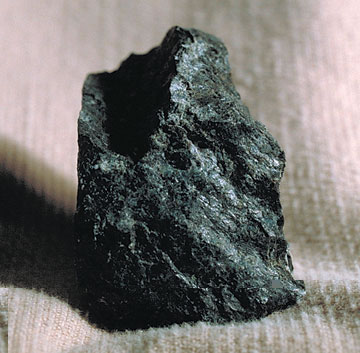
The serpentine group describes a group of common rock-forming hydrous magnesium iron phyllosilicate ((Mg,Fe)3Si2O5(OH)4) minerals; they may contain minor amounts of other elements including chromium, manganese,cobalt or nickel. In mineralogy and gemology, serpentine may refer to any of 20 varieties belonging to the serpentine group. Owing to admixture, these varieties are not always easy to individualize, and distinctions are not usually made. There are three important mineral polymorphs of serpentine: antigorite, chrysotile and lizardite.
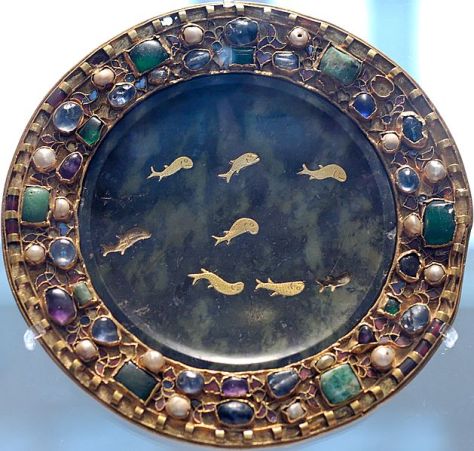
The chrysotile group of minerals are polymorphous, meaning that they have the same chemical formulae, but the molecules are arranged into different structures, or crystal lattices. Chrysotile with a fiberous habit is one type ofasbestos. Other minerals in the chrysotile group may have a platy habit.
Many types of serpentine have been used for jewellery and hardstone carving, sometimes under the name false jade or Teton jade.
Overview
Their olive green color and smooth or scaly appearance is the basis of the name from the Latin serpentinus, meaning “serpent rock,” according to Best (2003). They have their origins in metamorphic alterations of peridotite andpyroxene. Serpentines may also pseudomorphously replace other magnesium silicates. Alterations may be incomplete, causing physical properties of serpentines to vary widely. Where they form a significant part of the land surface, the soil is unusually high in clay.

Antigorite is the polymorph of serpentine that most commonly forms during metamorphism of wet ultramafic rocks and is stable at the highest temperatures—to over 600 °C at depths of 60 km or so. In contrast, lizardite and chrysotile typically form near the Earth’s surface and break down at relatively low temperatures, probably well below 400 °C. It has been suggested that chrysotile is never stable relative to either of the other two serpentine polymorphs.
Samples of the oceanic crust and uppermost mantle from ocean basins document that ultramafic rocks there commonly contain abundant serpentine. Antigorite contains water in its structure, about 13 percent by weight. Hence, antigorite may play an important role in the transport of water into the earth in subduction zones and in the subsequent release of water to create magmas in island arcs, and some of the water may be carried to yet greater depths.
Soils derived from serpentine are toxic to many plants, because of high levels of nickel, chromium, and cobalt; growth of many plants is also inhibited by low levels of potassium and phosphorus and a low ratio of calcium/magnesium. The flora is generally very distinctive, with specialised, slow-growing species. Areas of serpentine-derived soil will show as strips ofshrubland and open, scattered small trees (often conifers) within otherwise forested areas; these areas are called serpentine barrens.
Most serpentines are opaque to translucent, light (specific gravity between 2.2–2.9), soft (hardness 2.5–4), infusible and susceptible to acids. All are microcrystalline and massive in habit, never being found as single crystals. Luster may be vitreous, greasy or silky. Colours range from white to grey, yellow to green, and brown to black, and are often splotchy or veined. Many are intergrown with other minerals, such as calcite and dolomite. Occurrence is worldwide; New Caledonia, Canada (Quebec), USA (northernCalifornia, Rhode Island, Connecticut, Massachusetts, Maryland and southern Pennsylvania), Afghanistan, Britain (Cornwall and Ireland), Greece(Thessaly), China, Ural Mountains (Russia), France, Korea, Austria (Styria and Carinthia), India (Assam, and Manipur), Myanmar (Burma), New Zealand,Norway and Italy are notable localities.
Serpentines find use in industry for a number of purposes, such as railway ballasts, building materials, and the asbestiform types find use as thermal and electrical insulation (chrysotile asbestos). The asbestos content can be released to the air when serpentine is excavated and if it is used as a road surface, forming a long term health hazard by breathing. Asbestos from serpentine can also appear at low levels in water supplies through normal weathering processes, but there is as yet no identified health hazard associated with use or ingestion. In its natural state, some forms of serpentine react with carbon dioxide and re-release oxygen into the atmosphere.
The more attractive and durable varieties (all of antigorite) are termed “noble” or “precious” serpentine and are used extensively as gems and in ornamental carvings. The town of Bhera in the historic Punjab province of the Indian subcontinent was known for centuries for finishing a relatively pure form of green serpentine obtained from quarries in Afghanistan into lapidary work, cups, ornamental sword hilts, and dagger handles. This high-grade serpentine ore was known as sang-i-yashm or to the English, false jade, and was used for generations by Indian craftsmen for lapidary work. It is easily carved, taking a good polish, and is said to have a pleasingly greasy feel. Less valuable serpentine ores of varying hardness and clarity are also sometimes dyed to imitatejade. Misleading synonyms for this material include “Suzhou jade”, “Styrian jade”, and “New jade”.
New Caledonian serpentine is particularly rich in nickel. The Māori of New Zealand once carved beautiful objects from local serpentine, which they called tangiwai, meaning “tears”.
The lapis atracius of the Romans, now known as verde antique, or verde antico, is a serpentinite brecciapopular as a decorative facing stone. In classical times it was mined at Casambala, Thessaly, Greece. Serpentinite marbles are also widely used: Green Connemara marble (or Irish green marble) fromConnemara, Ireland (and many other sources), and red Rosso di Levanto marble from Italy. Use is limited to indoor settings as serpentinites do not weather well.
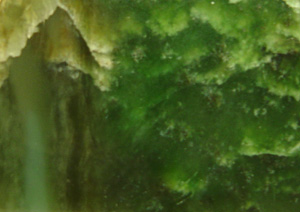
Antigorite
Lamellated antigorite occurs in tough, pleated masses. It is usually dark green in colour, but may also be yellowish, gray, brown or black. It has a hardness of 3.5–4 and its lustre is greasy. The monoclinic crystals show micaceous cleavage and fuse with difficulty. Antigorite is named after its type locality, the Geisspfad serpentinite, Valle Antigorio in border region Italy/ Switzerland.
Bowenite is an especially hard serpentine (5.5) of a light to dark apple green colour, often mottled with cloudy white patches and darker veining. It is the serpentine most frequently encountered in carving and jewellery. The name retinalite is sometimes applied to yellow bowenite. The New Zealand material is called tangiwai.
Although not an official species, bowenite is the state mineral of Rhode Island: this is also the variety’s type locality. A bowenite cabochon featured as part of the “Our Mineral Heritage Brooch”, was presented to First Lady Mrs. Lady Bird Johnson in 1967.
Williamsite is a local varietal name for antigorite that is oil-green with black crystals of chromite or magnetite often included. Somewhat resembling fine jade, williamsite is cut into cabochons and beads. It is found mainly in Maryland and Pennsylvania, USA.
Gymnite is an amorphous form of antigorite.] It was originally found in the Bare Hills, Maryland, and is named from the Greek, gymnos meaning bare or naked.
State Emblem
In 1965 the California Legislature designated serpentine (the mineral) as “the official State Rock and lithologic emblem.”
Source: Wikipedia
8. Aventurine
Aventurine is a form of quartz, characterised by its translucency and the presence of platy mineral inclusionsthat give a shimmering or glistening effect termed aventurescence.

The most common colour of aventurine is green, but it may also be orange, brown, yellow, blue, or gray. Chrome-bearing fuchsite (a variety of muscovite mica) is the classic inclusion, and gives a silvery green or blue sheen. Oranges and browns are attributed to hematite or goethite. Because aventurine is a rock, its physical properties vary: its specific gravity may lie between 2.64-2.69 and its hardness is somewhat lower than single-crystal quartz at around 6.5.
Aventurine feldspar or sunstone can be confused with orange and red aventurine quartzite, although the former is generally of a higher transparency. Aventurine is often banded and an overabundance of fuchsite may render it opaque, in which case it may be mistaken for malachite at first glance.
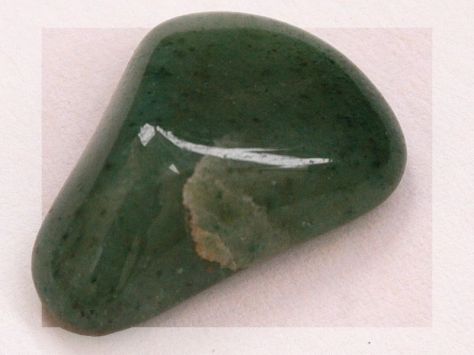
The name aventurine derives from the Italian “a ventura” meaning “by chance”. This is an allusion to the lucky discovery of aventurine glass or goldstone at some point in the 18th century. Although it was known first, goldstone is now a common imitation of aventurine and sunstone. Goldstone is distinguished visually from the latter two minerals by its coarse flecks of copper, dispersed within the glass in an unnaturally uniform manner. It is usually a golden brown, but may also be found in blue or green.
The majority of green and blue-green aventurine originates in India (particularly in the vicinity of Mysore and Madras) where it is employed by prolific artisans. Creamy white, gray and orange material is found in Chile, Spain and Russia. Most material is carved into beads and figurines with only the finer examples fashioned into cabochons, later being set into jewellery.
Source: Wikipedia
9. Sodalite
Sodalite is a rich royal blue mineral widely enjoyed as an ornamental gemstone. Although massive sodalite samples are opaque, crystals are usually transparent to translucent. Sodalite is a member of the sodalite group with hauyne, nosean, lazurite and tugtupite.
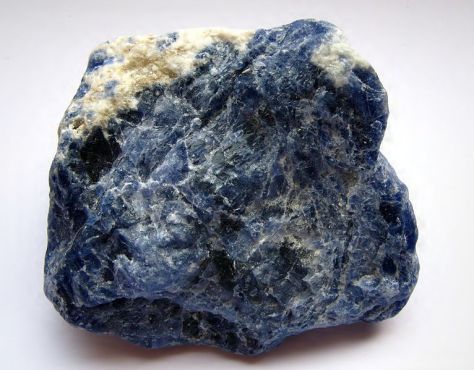
Discovered in 1811 in the Ilimaussaq intrusive complex in Greenland, sodalite did not become important as an ornamental stone until 1891 when vast deposits of fine material were discovered in Ontario, Canada.
Properties
A light, relatively hard yet fragile mineral, sodalite is named after itssodium content; in mineralogy it may be classed as a feldspathoid. Well known for its blue color, sodalite may also be grey, yellow, green, or pink and is often mottled with white veins or patches. The more uniformly blue material is used in jewellery, where it is fashioned into cabochons andbeads. Lesser material is more often seen as facing or inlay in various applications.

Although somewhat similar to lazurite and lapis lazuli, sodalite rarely contains pyrite (a common inclusion in lapis) and its blue color is more like traditional royal blue rather than ultramarine. It is further distinguished from similar minerals by its white (rather than blue) streak. Sodalite’s six directions of poor cleavage may be seen as incipient cracks running through the stone.
Hackmanite

Hackmanite is an important variety of sodalite exhibiting tenebrescence. When hackmanite from Mont Saint-Hilaire (Quebec) or Ilímaussaq (Greenland) is freshly quarried, it is generally pale to deep violet but the colour fades quickly to greyish or greenish white. Conversely, hackmanite from Afghanistan and the Myanmar Republic (Burma) starts off creamy white but develops a violet to pink-red colour in sunlight. If left in a dark environment for some time, the violet will fade again. Tenebrescence is accelerated by the use of longwave or, particularly, shortwave ultraviolet light. Much sodalite will also fluoresce a patchy orange under UV light.
Occurrence
Sodalite was first described in 1811 for the occurrence in its type locality in the Ilimaussaq complex, Narsaq,West Greenland.
Occurring typically in massive form, sodalite is found as vein fillings in plutonic igneous rocks such as nepheline syenites. It is associated with other minerals typical of undersaturated environments, namely leucite, cancriniteand natrolite. Other associated minerals include nepheline, titanian andradite, aegirine, microcline, sanidine,albite, calcite, fluorite, ankerite and baryte.
Significant deposits of fine material are restricted to but a few locales: Bancroft, Ontario, and Mont-Saint-Hilaire, Quebec, in Canada; and Litchfield, Maine, and Magnet Cove, Arkansas, in the USA. The Ice River complex, near Golden, British Columbia, contains sodalite. Smaller deposits are found in South America (Brazil and Bolivia),Portugal, Romania, Burma and Russia. Hackmanite is found principally in Mont-Saint-Hilaire and Greenland.
Euhedral, transparent crystals are found in northern Namibia and in the lavas of Vesuvius, Italy.
Source: Wikipedia
…





Good day! I know this is somewhat off topic butt I was wondering iif you knew where I could find a captcba pljgin for my comment form?
I’m using thhe same blog platform as yours and I’m having problems
finding one? Thanks a lot!
LikeLike